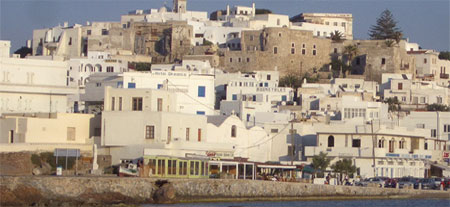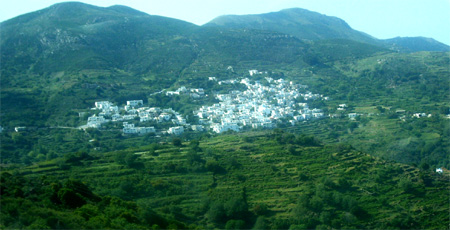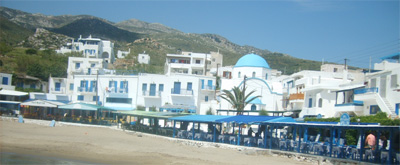The island of Naxos is the largest island in the Cyclades with 423 square kilometers and has about 15,000 inhabitants. It is a typical Cycladic island. There is a lot of package tourism, but not as excessive as on Mykonos or Santorini. Individual tourists and backpackers are still found in large numbers (although cheap accommodation is becoming increasingly rare). The plus points of the island of Naxos are the beautiful beaches and the size of the island. There are many remote areas, far away from the tourist resorts. The island has fewer visitors than the neighboring islands of Santorini, Paros or Mykonos. This is unjustified: Naxos has everything a tourist needs. An attractive town, wonderful sandy beaches south of the capital and one of the best hiking areas in Greece in the interior of the island.
Our opinion: Naxos impresses with its relaxed atmosphere and a harmonious mix of beautiful beaches and traditional life. Some areas may seem a little too quiet for the adventurous, especially compared to more lively islands. Nevertheless, the island offers just the right charm for those seeking relaxation and those interested in culture.
Our articles about Naxos |
|
| Naxos Overview | Naxos Town |
| Apollonas Naxos | Agia Anna Naxos |
| Naxos East | Naxos Tragea |
The attractive capital with a Venetian castle and the beautiful old town is called Naxos Town. The narrow districts of Burgos and Agora have hardly changed since the Middle Ages. The capital can be reached by ferry. The place has become a fully developed tourist resort. There are around 100 hotels, an old town worth seeing and the complete infrastructure of a fully developed tourist resort.
90% of holidaymakers stay in the town of Naxos or on the beaches south of the island’s capital. The town beach of Agios Georgios, with its shallow waters and sheltered location, is one of the best family beaches in the Cyclades.
Agios Prokopios is a well-known holiday resort with beautiful beaches. Until a few years ago, Plaka was an insider tip for dropouts and hippies. Today, there is normal tourism here too, including sunbeds on the beach for which you have to pay. The only nudist beach on the island of Naxos begins behind Plaka. There are many regulars here. There are three good campsites on the beaches south of the capital (in Agia Anna, Agios Apollon and Agios Georgios).
Tip: Our favorite guesthouse on Naxos: Infinity Appartments
Tragea, the interior of Naxos, which is largely undeveloped for tourism, is a paradise for hikers. In addition to original villages where you can stay cheaply in simple guesthouses, Tragea offers plenty of nature, a real rural Greek atmosphere and peace. For many, the highlight is climbing Zas, the highest mountain on Naxos and the whole of the Cyclades. It is a green island for the Cyclades. Agriculture, with a surprising amount of arable farming and dairy farming for Greece, is still a major economic factor on the island. Fruits such as figs and oranges, olives, wine, corn and grain are grown. Thanks to the construction of new roads, the hinterland of Naxos is now much more accessible than before. The number of visitors with rental cars, hikers and bus excursionists has increased significantly as a result. During the season, there are several daily day trips by bus from the capital (costs around 30-40) to the Tragea, usually under the title “Island Tour” or “Island Tour”.
A small, nice holiday resort is Apollonas in the north of the island. Apollonas is especially suitable for a quiet beach and relaxation holiday. The village is two hours by bus from Naxos town (great trip across the islands).
The best day tours from Naxos1. Boat trip with food and drink: Remote beaches, swimming, snorkeling, etc. Great tour with catamaran: More info and booking 2. Bus tour through Naxos: Focus of the tour Apollonas: More info and booking |
How to get to Naxos?
There are two main ways to get to Naxos:
1. Flight to Naxos
Domestic flights:
Naxos has a small airport (JNX) with flights from Athens (about 40 minutes).
International flights to Naxos are not possible; you have to travel via Athens.
2. Ferry to Naxos
From Athens (usually Piraeus or less frequently Rafina):
Fast ferry: 3-4 hours.
Normal ferry: 5-6 hours.
From other Cyclades islands:
The island is a major ferry hub and easily accessible from islands such as Mykonos, Paros, Santorini or Ios.
➔ To book ferries within Greece, we recommend the reputable website Ferryscanner.com
Summary:
Flight: Via Athens (domestic flight).
Ferry: From Piraeus, Rafina or other Cyclades islands.
➔ Book Naxos hotels for 2025 now at a low price
During the season, excursion boats leave several times a week for Delos, Mykonos, Santorini, Paros and other islands. The day trip to Delos and Mykonos is popular (3 hours stay each for €40 per person).
Most holidaymakers book day trips from Naxos by boat and bus online: >>> Link to the booking page
The bus connections on Naxos are pretty good. There are several buses a day all year round to all the larger villages in the interior and to Apollonas. In winter (until about May 15th) only a few buses a day go to the tourist beaches in the south of the capital, but in summer there are connections every hour or half hour. Fortunately, many people think that the island has not yet made a major tourist breakthrough, as the island only has a small airport. If you want to go directly to the island from Germany, you have two options: you can fly to Athens and then take the small plane that leaves several times a day, or you can fly by charter to Mykonos or Santorini and take the ferry from there to Naxos several times a day. The airport has no direct bus connection, but the frequent buses from the bus station to Agia Anna stop nearby. The taxis at the airport are rather expensive, a trip to the center costs about 15 euros for 5 km. Horseback riding is also popular with holidaymakers.
Good and cheap accommodation in Naxos Town is the Soula Hotel (also dormitory) and Naxos Windmill.
Fans of water sports can turn to the Flisvos Sport Club. Here, in the south of the capital on Agios Georgios beach, windsurfing, kiting, sailing, hiking, mountain biking and other fitness sports are offered.
More information about the places can be found in this travel guide on the following pages:
Chora: The bustling tourist metropolis on the island
Tragea: The hiking paradise in the center of Naoxs
Apollonas: The small fishing village in the north
Agia Anna: The tourist resort south of the capital
East Naxos: Almost deserted coast and beaches
|
Naxos is significantly larger than its even more famous neighbor Paros to the west. To the south and east are the small Cyclades islands. |
|
|


